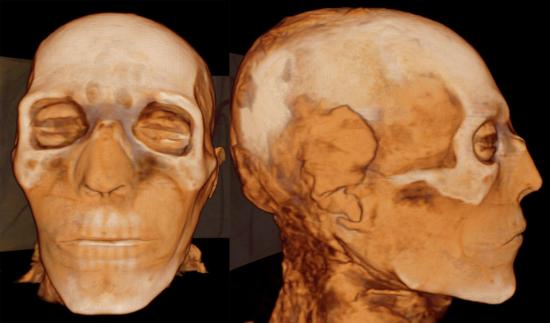 As a result of subcutaneous packing, the mummy of King Seti I (1294-1279 BC) has “the most life-like and attractive face of the many Egyptian mummies, royal and commoner, that have survived down to present time,” according to the authors. SAHAR SALEEM
As a result of subcutaneous packing, the mummy of King Seti I (1294-1279 BC) has “the most life-like and attractive face of the many Egyptian mummies, royal and commoner, that have survived down to present time,” according to the authors. SAHAR SALEEM
Lydia Belanger
Source - http://www.wired.com/2015/12/modern-medicine-resolves-the-mysteries-of-egypts-royal-mummies/
Roughly 400 miles from the Great Pyramids, ancient pharaohs of the New Kingdom lay at rest in the Valley of Kings. Nondescript chambers built into the valley’s dusty hills hold royal remains, buried between 1550 and 1070 BC. The crypts were designed to deter robbers, and for the most part, they worked—which makes it difficult for today’s archaeologists to find them and identify their inhabitants.
 Scholars believed that a well-documented assassination attempt on Ramesses III failed, but CT scans showed a sharp knife wound in his neck—and an amulet placed within it to promote healing. SAHAR SALEEM
Scholars believed that a well-documented assassination attempt on Ramesses III failed, but CT scans showed a sharp knife wound in his neck—and an amulet placed within it to promote healing. SAHAR SALEEM
But new techniques are giving researchers a better look into the tombs. In particular, a team of radiologists and geneticists hopes to prove that an unidentified mummy known as KV21b is the long-sought Queen Nefertiti—King Tut’s stepmother. Modern analysis, from CT scanning to DNA testing, is offering new clues into the history of this royal family. And after 10 years of work, the researchers Zahi Hawass and Sahar Saleem are presenting their findings in the book Scanning the Pharaohs: CT Imaging of the New Kingdom Royal Mummies.
Nineteenth-century explorers discovered two mummies in chamber KV21, which are now located in the Egyptian Museum in Cairo.
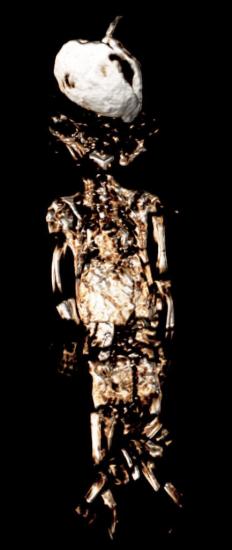 King Tut had two stillborn daughters buried with him in his tomb. This one died at five months of gestation. SAHAR SALEEM
King Tut had two stillborn daughters buried with him in his tomb. This one died at five months of gestation. SAHAR SALEEM
Using new techniques, the so-called Egyptian Mummy Project proved that one of them is the mother of Tut’s two stillborn daughters—likely Ankhesenamun, who was Tut’s only wife. “Beside her, there is a headless mummy,” says co-author Zahi Hawass, who formerly held the office of Egyptian Minister of Antiquities. “We think that this mummy could be the mummy for Queen Nefertiti.” Nefertiti was, after all, Ankhesenamun’s mother, so it makes sense that the two might have been buried together. The researchers need more time to analyze
the data before they can be sure—they plan to locate other relatives of Nefertiti and see if the DNA matches. But their methods have already answered other questions about Nefertiti’s royal family. “It sheds light on some Egyptological conundrums that have been debated for years, especially in the absence of written records,” says Sue D’Auria, who edited the book.
What Lies Beneath
Researchers first x-rayed Tut in 1968, but the two-dimensional images from traditional X-rays didn’t provide enough detail to confirm what physical ailments brought him suffering and early death. CT imaging creates cross sections of the body, in addition to highlighting soft tissues. “We cannot say something about liver or heart diseases,” says Saleem, a professor of radiology at Cairo University who specializes in paleopathology. “But we can do a lot of anthropological work.” Saleem had examined mummy radiographs at the University of Western Ontario before Hawass invited her to join the project.
Hawass’ team performed a CT scan on King Tut’s remains in 2005, making him the first royal mummy to receive the treatment. After extensive analysis of more than 1,700 images, Saleem and other experts determined that Tut was around 19 years old when he died. They also distinguished the physical damage caused by handlers after Tut’s death from ailments he suffered from during his lifetime. Saleem explains that embalmers extracted Tut’s brain through his nose pour hot plant resin into his skull.
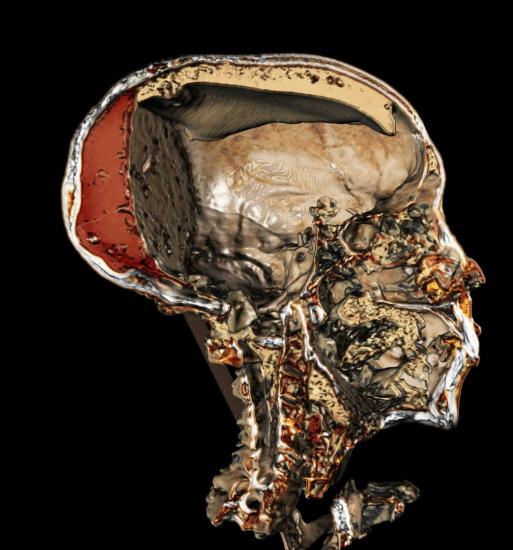 CT imaging provides a detailed view of King Tut's mummified skull, including the resin material embalmers filled it with. SAHAR SALEEM
CT imaging provides a detailed view of King Tut's mummified skull, including the resin material embalmers filled it with. SAHAR SALEEM
For years, scholars believed a head trauma killed him, based on a small bone fragment found in his skull. But if this bone fragment had been present at the time of mummification, the embalming fluid would have adhered to it, the authors explain. In reviewing scans of the rest of the body, Saleem came up with a new theory: Tut probably died from a bad knee fracture instead.
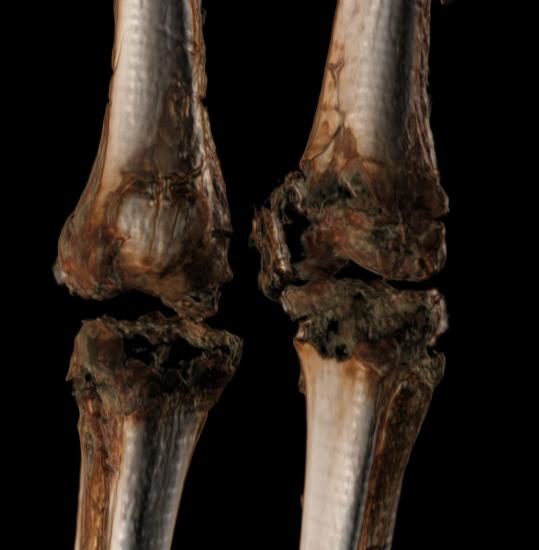 King Tut suffered complications from a knee injury. Experts previously thought Tut died from a fatal blow to the head, but the condition of his knee makes it the likely culprit. SAHAR SALEEM
King Tut suffered complications from a knee injury. Experts previously thought Tut died from a fatal blow to the head, but the condition of his knee makes it the likely culprit. SAHAR SALEEM
On top of that, the presence of a malaria-causing pathogen indicates the disease may have weakened his immune system. The scans also reveal a previously unknown congenital deformity of Tut’s left foot that forced him to walk with a cane.
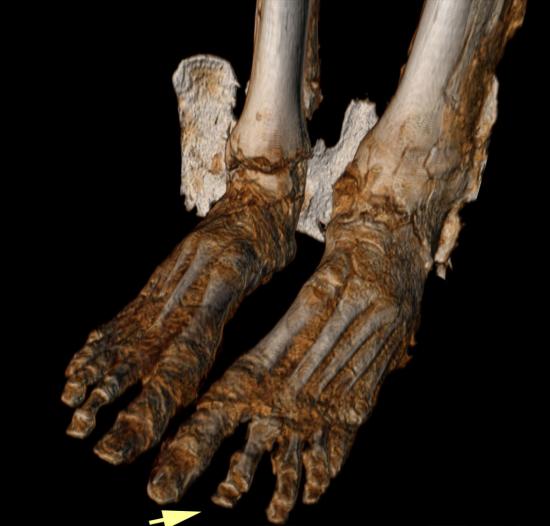 Possibly as a result of parental incest, King Tut suffered bone deformities in his second toe on his left foot. This caused the young king to walk with a cane. SAHAR SALEEM
Possibly as a result of parental incest, King Tut suffered bone deformities in his second toe on his left foot. This caused the young king to walk with a cane. SAHAR SALEEM
This information jibes with the 130 walking sticks discovered in Tut’s tomb, and the many drawings of the young king that depict him sitting down—even while, say, hunting. The fact that Tut’s parents (the Younger Lady and Akhenaten) were siblings, as the authors discovered, could explain this defect.
Not all studies turned up new maladies, however. The team analyzed two small mummies buried in a wooden box in Tut’s tomb. They were Tut’s stillborn daughters, as indicated by their DNA. Their mother was one of the mummies in KV21—likely Ankhesenamun, Tut’s only wife. They also disproved previous claims that the fetuses had bone anomalies, and they confirmed their ages at the time of their miscarriages.
“When I started to do this kind of work, I didn’t have any reference to look at,” Saleem says of CT scanning the fetal mummies. “This was a methodology in forensic studies that had never been described before.” Modern medical techniques allow researchers to make discoveries about the royal mummies that would otherwise be impossible, from congenital illnesses to family ties. In turn, they unlock whole new fields of study. When the ancient Egyptians mummified their dead, they never could have predicted how many secrets they were burying with them.